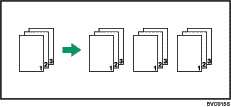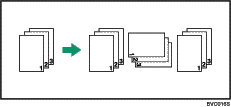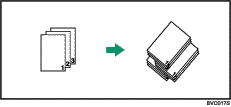


  |  | ||
When printing multiple documents such as handouts for meetings, you can separate sets into order. This function is known as "Collate". Collate stores data transmitted from a computer to the machine's memory or hard disk drive.
![]()
You can sort up to 3000 pages, and up to 9999 copies.
If [Auto Continue] occurs on the first set, Collate will be canceled. For details about [Auto Continue], see "System".
If you make the machine continue printing manually on the first set, Collate will be canceled. For details about making the machine continue printing manually, see "If Error Occurs with the Specified Paper Size and Type".
If the [Ignore Application Collate] check box is cleared, the collate settings in the application's [Print] dialog box are applied.
The followings are the three types of Collate.
Collate
Printed output is assembled as sets in sequential order.

Rotating Collate
Every other print set is rotated by 90 degrees.
When the two paper trays contain the same size paper and same paper type in different orientations, the output result will be always Rotating Collate.

Conditions where Rotate Collate will be canceled
When combined with the staple function.
When combined with the punch function.
When a paper tray is specified.
When combined with the tab stock function.
When combined with the chaptering function.
If custom size paper is set.
When the output tray has the shift function.
If jobs containing pages of various sizes are set.
When combined with the cover sheet or back cover sheet functions.
When combined with the slip sheet function.
When combined with the fold function.
When combined with ring binding function.
Shift Collate
An optional finisher is required for this function.

The finisher shift tray moves backward or forward when a job or set is output, causing the next to shift, so you can separate them.
Separation Sheet
A separation sheet is inserted between each set.
Separation sheets are fed from the tray specified in the machine's default settings. For details about the separation sheet tray, see "System Settings", Network and System Settings Reference.
Condition where Separation Sheet will be canceled
When combined with the staple function.
![]()
This function is also available using the PostScript 3 printer driver. For details, see PostScript 3 Supplement.
Folding types other than Z-fold cannot be used with the separation sheet function.
Ring binding function cannot be used with the separation sheet function.
When combined with the punch function, the punch function does not apply on separation sheets.
If both Sample Print and the separation sheet function are enabled, separation sheets will not be inserted in the first copy set.
If both the cover sheet and separation sheet functions are enabled, a separation sheet will be inserted before the cover sheet.
Rotating Collate does not apply in separation sheets.
If both the [Extended Auto Tray Switching] setting and the Rotating Collate function are enabled when paper in the selected tray runs out, the [Extended Auto Tray Switching] setting will be disabled. An error message reporting paper empty will then be displayed.
When Rotating Collate has been selected, printing speed will be slower than with other collate functions.
Separation sheets cannot be inserted if "Slip Sheet" is specified.
If you cannot make Shift Collate even with an optional finisher installed, options may not be set up correctly in the printer driver. To correct the printer driver's option settings, see "Making Option Settings for the Printer".
For details, see the printer driver Help.